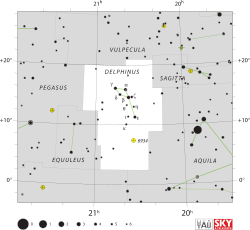 A star chart of the Delphinus constellation showing the position of δ Delphinus (circled) | |
| Observation data Epoch J2000.0 Equinox J2000.0 | |
|---|---|
| Constellation | Delphinus |
| Right ascension | 20 43 27.53338 |
| Declination | +15° 04′ 28.4773″ |
| Apparent magnitude (V) | 4.43 (4.38 - 4.49) |
| Characteristics | |
| Spectral type | kA7hF1VmF1pSrEuCr: |
| B−V color index | +0.302 |
| Variable type | δ Sct |
| Astrometry | |
| Radial velocity (Rv) | 9.48±0.07 km/s |
| Proper motion (μ) | RA: −20.44 mas/yr Dec.: −43.33 mas/yr |
| Parallax (π) | 14.61 ± 0.20 mas |
| Distance | 223 ± 3 ly (68.4 ± 0.9 pc) |
| Absolute magnitude (MV) | +0.25 |
| Orbit | |
| Period (P) | 40.60505±0.00014 d |
| Semi-major axis (a) | 5.4676±0.0037 |
| Eccentricity (e) | 0.64008±0.00018 |
| Inclination (i) | 13.92±0.18° |
| Longitude of the node (Ω) | 63.73±0.33° |
| Periastron epoch (T) | 56823.5019±0.0028 MJD |
| Argument of periastron (ω) (secondary) | 65.07±0.32° |
| Semi-amplitude (K1) (primary) | 13.88±0.14 km/s |
| Semi-amplitude (K2) (secondary) | 15.27±0.07 km/s |
| Details | |
| δ Del A | |
| Mass | 1.78 M☉ |
| Radius | 3.43 R☉ |
| Luminosity | 32.4 L☉ |
| Surface gravity (log g) | 3.71 cgs |
| Temperature | 7,440±210 K |
| Metallicity | −0.5 dex |
| Rotational velocity (v sin i) | 17 km/s |
| Age | 945 Myr |
| δ Del B | |
| Mass | 1.62 M☉ |
| Radius | 3.48 R☉ |
| Luminosity | 28.8 L☉ |
| Temperature | 7,110±180 K |
| Rotational velocity (v sin i) | 12 km/s |
| Other designations | |
| δ Del, 11 Del, BD+14°4403, HD 197461, HIP 102281, HR 7928, SAO 106425 | |
| Database references | |
| SIMBAD | data |
Delta Delphini, Latinized from δ Delphini, is a binary star in the northern constellation of Delphinus. It is visible to the naked eye with an apparent visual magnitude of 4.43. Based upon an annual parallax shift of 14.61 mas as seen from the Earth, the system is located about 223 light years from the Sun.

This is a double-lined spectroscopic binary system with an orbital period of 40.58 days. The two components are nearly identical chemically peculiar stars, having a combined stellar classification of kA7hF1VmF1pSrEuCr:. This notation indicates the calcium K line matches an A7 star, the hydrogen lines an F1 star, and the metal lines an F1 star, with particularly strong lines of strontium, europium, and chromium. Each of the stars is a Delta Scuti variable, with the system having a dominant period of 0.1568 days and an amplitude of 0.0700 in magnitude. Delta Delphini forms the prototype of a class of metal-lined δ Scuti subgiant or giant stars.
References
- ^ van Leeuwen, F. (2007), "Validation of the new Hipparcos reduction", Astronomy and Astrophysics, 474 (2): 653–664, arXiv:0708.1752, Bibcode:2007A&A...474..653V, doi:10.1051/0004-6361:20078357, S2CID 18759600.
- ^ Chang, S.-W.; et al. (2013), "Statistical Properties of Galactic δ Scuti Stars: Revisited", The Astronomical Journal, 145 (5): 132, arXiv:1303.1031, Bibcode:2013AJ....145..132C, doi:10.1088/0004-6256/145/5/132, S2CID 118900730.
- ^ Samus, N. N.; Durlevich, O. V.; et al. (2009), "VizieR Online Data Catalog: General Catalogue of Variable Stars (Samus+ 2007-2013)", VizieR On-line Data Catalog: B/GCVS. Originally Published in: 2009yCat....102025S, 1, Bibcode:2009yCat....102025S.
- Gray, R. O.; Napier, M. G.; Winkler, L. I. (April 2001), "The Physical Basis of Luminosity Classification in the Late A-, F-, and Early G-Type Stars. I. Precise Spectral Types for 372 Stars", The Astronomical Journal, 121 (4): 2148–2158, Bibcode:2001AJ....121.2148G, doi:10.1086/319956.
- ^ Gardner, Tyler; et al. (2018), "Precision Orbit of δ Delphini and Prospects for Astrometric Detection of Exoplanets", The Astrophysical Journal, 855 (1), 1, arXiv:1802.00468, Bibcode:2018ApJ...855....1G, doi:10.3847/1538-4357/aaac80, S2CID 7642698.
- Anderson, E.; Francis, Ch. (2012), "XHIP: An extended hipparcos compilation", Astronomy Letters, 38 (5): 331, arXiv:1108.4971, Bibcode:2012AstL...38..331A, doi:10.1134/S1063773712050015, S2CID 119257644.
- ^ David, Trevor J.; Hillenbrand, Lynne A. (2015), "The Ages of Early-Type Stars: Strömgren Photometric Methods Calibrated, Validated, Tested, and Applied to Hosts and Prospective Hosts of Directly Imaged Exoplanets", The Astrophysical Journal, 804 (2): 146, arXiv:1501.03154, Bibcode:2015ApJ...804..146D, doi:10.1088/0004-637X/804/2/146, S2CID 33401607.
- "del Del", SIMBAD, Centre de données astronomiques de Strasbourg, retrieved 2017-06-28.
- ^ Liakos, Alexios; Niarchos, Panagiotis (February 2017), "Catalogue and properties of δ Scuti stars in binaries", Monthly Notices of the Royal Astronomical Society, 465 (1): 1181–1200, arXiv:1611.00200, Bibcode:2017MNRAS.465.1181L, doi:10.1093/mnras/stw2756.
- "Light Curve", Hipparcos ESA, ESA, retrieved 31 August 2022.
- Baade, D.; Bardelli, S.; Beaulieu, J. Ph.; Vogel, S. (March 1993), "A spectroscopic search for nonradial pulsations in the Delta Scuti stars Delta Delphini and Epsilon Cephei", Astronomy and Astrophysics, 269 (1–2): 195–200, Bibcode:1993A&A...269..195B.
External links
- Kaler, James B. (August 3, 2007), "Delta Delphini", Stars, University of Illinois, retrieved 2017-06-28.
| Constellation of Delphinus | |||||||||||||
|---|---|---|---|---|---|---|---|---|---|---|---|---|---|
| Stars |
| ||||||||||||
| |||||||||||||
| |||||||||||||
| |||||||||||||
| Galaxies |
| ||||||||||||